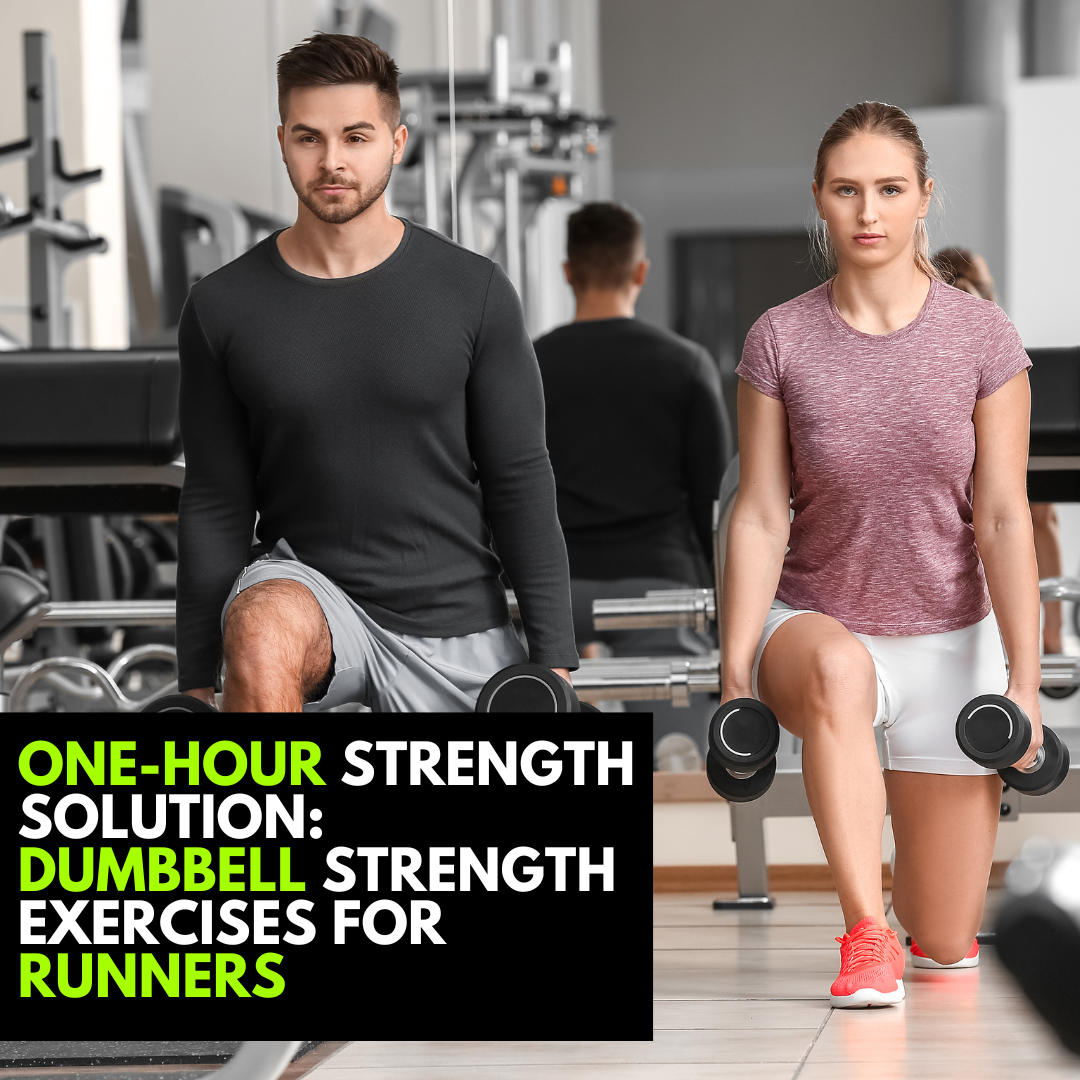Subscribe to The Adaptive Zone Podcast…
The One-Hour Strength Solution: Dumbbell Strength Exercises for Runners
I was giving a talk at a running club a couple of weeks ago about strength training for runners. I asked the group to raise their hand if they were doing regular strength training. Only a few hands went up. Then I asked them to raise their hand if they had heard that strength training was good for runners.
All the hands went up.
This is real progress, it was only a few years ago that runners believed strength training was not only unhelpful, but that it would actually make them slower. This perspective has really shifted in the last few years. Nowadays, most runners understand that strength training will improve their performance and help them avoid injuries.
However, as I said, when I asked them who was actually doing it, only a few hands went up. In my opinion, this is a fairly representative sample of the running community at large. We now believe that strength training is a good thing to do, but not that many of us are actually doing it.
So today, I hope to do my little bit to help turn the tide. I’m going to outline how you can get into strength training. This week. I’ll go through a really simple workout that you can do to get the best bang for your buck out of your strength training. You can do it at home in less than an hour per week. All you’re going to need are a couple of heavy dumbbells.

What are the Benefits of Strength Training for Runners?
The fact is that strength training is essential for everyone, not just runners. We lose about 1% of our muscle mass every year after we hit age 30. If you’re not strength training, you could have lost 30-40% of your muscle mass by the time you’re ready to retire. This is where frailty comes from.
We all have an older relative who is bone thin and struggles to get up from the ground. This is not some unavoidable reality of ageing. It is simply the cumulative effect of decades of deconditioning. It can be avoided.
If you’re lifting heavy weights for about an hour every week, this won’t happen. That’s not the only benefit of strength training either, check out this epic little list:
- Improves running performance (Blagrove 2018)
- Increases bone density (Hong 2018)
- Reduces body fat (Wewege 2022)
- Reduces fat storage around the abdomen (Allman 2019)
- Improves tendon stiffness (Albracht 2013)
- Prevents age-related muscle loss (Yoo 2018)
- Improves sleep (Yang 2012)
- Prevents death (Kraschnewski 2016) – not indefinitely*
Why Strength Training with Dumbbells?
The most obvious reason to use dumbbells for strength training is practicality. They’re relatively cheap and easy to find. If you buy them used, you can sometimes find a bargain. They hold their value well, so if you decide to upgrade to a gym membership at some point, you can sell them on.
The main problem with runners using dumbbells for strength training is that they tend to buy weights that are too light. Many of the runners who are actually doing some strength training won’t see many of the benefits they were hoping for. We need to make sure that you are actually getting stronger and this brings me to my next point.
Lift Heavy Shit
I borrowed this term from Dr. Stacey Sims. It makes the concept nice and easy to communicate. If you really want to get stronger, you have to lift heavy shit. If you can do more than 10 reps with the dumbbells you’re using, they’re just too light.
The only way to get stronger is to lift weights that are so heavy you convince your muscles they need to get stronger in order to survive. If you can do more than 10 reps of any given exercise, it is too easy and you need to increase the weight.
I like to start runners with 4 sets of 8. As they get stronger and more familiar with the exercises, I progress them onto 5 sets of 5. There is nothing magic about these numbers, but it keeps the rep range low enough to allow you to jack the weight up.
So if you’re going to buy some dumbbells, I would suggest doing one or two day-passes at your local gym first. Try out the workout below using the dumbbells at the gym. Once you’ve found a weight that you struggle to do 8 reps, you know what size dumbbells to buy.
For the exercises below, 100 lbs is about right for me. So if I wanted to do these exercises at home, I’d need to buy two 50 lb dumbbells. You might be about the same, or you might only need 20 or 30-lb dumbbells. You have to try it for yourself but, if in doubt, go heavier not lighter.
How often should Runners do Dumbbell Strength Training?
In the winter, you want to build up your strength for the following season. Try and hit 3 strength sessions per week. 20-30 minutes each. Make sure you go super heavy, then the workouts won’t take long and you’ll get significant strength improvements.
In the summer, you’ll be running more and just need to maintain the strength that you built up in the winter. Try and continue 1-2 strength sessions per week, again, 20-30 minutes per session should suffice.
What are the Best Dumbbell Strength Exercises for Runners?
As with most things, strength training for runners follows the Pareto Principle. Essentially, you will get 80% of the benefits from 20% of the effort. So let’s focus on that 20%. If we only focus on the most important things, we can get most of the benefits of strength training in less than an hour a week.
So we’re going to focus on compound exercises. These hit multiple muscle groups all at once. We’re also going to focus on the legs, as that is where running injuries happen and where running performance comes from. We’re going to get our strength from just two dumbbell strength exercises for runners.
Single Leg Calf Raise
When we run, about 50% of our propulsive power comes from the calf. Only 30% from the thigh and 20% from the hip area. So we will get far more improvement in our running if we make our calves 10% stronger, rather than our glutes.
The single-leg calf raise is a simple exercise. Stand on the edge of a step on one foot. Hold a heavy dumbbell in one hand and hold onto something for balance with the other. Keep your knee really straight and slowly move up and down into a calf raise. Easy.
Rear Lunge
Now, we want to get the thigh, hip and core muscles. The rear lunge works nicely here. Hold two heavy dumbbells in either hand. Step backwards and touch your knee down on the floor. Stand back up to where you started. Finish your reps on that leg, rest, and then do the other leg.
Like I said earlier, start with 4 sets of 8 reps. Make sure the dumbbells are heavy enough that you can only just finish the 8 reps. If you can do more than 10 reps, they’re too light.
Squat Jump
Now that we’ve got our 2 strength exercises, we want one that develops power. When we run, our foot is in contact with the ground for less than half a second. It’s no good having strong muscles if they can’t generate force quickly enough to propel you forward or catch you as you land. This is where power comes in. It’s the ability to express your strength very quickly.
A good exercise to help you develop power is the squat jump. Hold one heavy dumbbell by your chest, or two heavy dumbbells by your shoulders. Squat down until your thighs are parallel to the floor. Jump up as high as you can and land back in the squat position. Repeat 8 times and do 4 sets.
Once you get used to this exercise, the idea is to jump as high as you can, so don’t hold back.
How to progress
Spend a few weeks doing 4 sets of 8 of the three exercises:
- Single Leg Calf Raise
- Rear Lunge
- Squat Jump
Once you feel it’s getting a bit easy, increase the weight and switch to 5 sets of 5.
Summary
Strength training is good for your health and it’s good for your running. It will help you avoid injuries, improve your performance and live a longer, healthier life. It’s not very complicated or expensive and you can do it in less than an hour a week.
If this has motivated you to learn more about strength training for runners, check out my interview with Rich Blagrove. He’s a researcher at the University of Loughborough who is investigating the effects of strength training in runners.
What are the Best Strength Exercises for Runners?

Chapters
- 00:00 Introduction
- 01:13 How do I get started with dumbbell strength exercises for runners?
- 02:12 What are the benefits of strength training for runners?
- 03:07 Lift heavy sh*t
- 04:41 How often should I strength train per week?
- 05:45 How to do calf raises
- 06:19 How to do rear lunges
- 06:54 How to do squat jumps
More from Matthew Boyd Physio
- Free Online Course: Running Fundamentals
- Subscribe to The Adaptive Zone Podcast
- Subscribe to The Adaptive Zone YouTube Channel
- Facebook @matthewboydphysio
- Instagram @matthewboydphysio